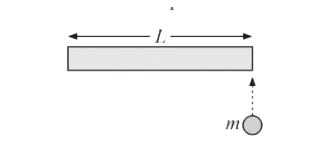A ball of mass 'm', moving with uniform speed, collides elastically with another stationary ball. The incident ball will lose maximum kinetic energy when the mass of the stationary ball is
m
2 m
4 m
Infinity
The correct Answer is:A
If mass = m
First ball will stop ⇒ v = 0
So k.e.=0 (min)
In other cases there will be some kinetic energy
(KE. can.t be negative)
Topper's Solved these Questions
- WORK, ENERGY AND POWERBook:PHYSICS WALLAHChapter:WORK, ENERGY AND POWERExercise:NEET Past 5 Years Questions
Explore 16 Videos
- WORK, ENERGY AND POWERBook:PHYSICS WALLAHChapter:WORK, ENERGY AND POWERExercise:NEET Past 5 Years Questions
Explore 16 Videos
- WAVESBook:PHYSICS WALLAHChapter:WAVESExercise:NEET PAST 4 YEARS QUESTIONS
Explore 15 Videos
Similar Questions
A stick of length L and mass M lies on a frictionless horizontal surface on which it is free to move in any way. A ball of mass m moving with speed v collides elastically with the stick as shown in the figure. If after the collision the ball comes to rest, then what would be the mass of the ball?

View SolutionA ball of mass m moving with velocity v collides head on elastically with another identical ball moving with velocity - V. After collision
View Solution
Knowledge Check
A Stick of length L and mass M lies on a fnctionless horizontal surface on which it is free to move in any way. A ball of mass m moving with speed v collides elastically with the stick as shownin figure-5.115. If after the collision ball comes to rest, then what should be the mass of the ball ?
 Am=2MBm=MCm=M/2Dm=M/4
Am=2MBm=MCm=M/2Dm=M/4A stick of length L and mass M lies on a frictionless horizontal surface on which it is free to move in any way. A ball of mass m moving with speed v collides elastically with the stick as shown in the figure. If after the collision the ball comes to rest, then what would be the mass of the ball?
 Am=2MBm=MCm=M/2Dm=M/4
Am=2MBm=MCm=M/2Dm=M/4A ball of mass 5 kg moving with speed 8 m/s collides head on with another stationary ball of mass 15 kg. If collision is perfecty inelastic, then loss in kinetic energy is
A160 JB80 JC40 JD120 J
A ball of mass M collides elastically with another stationary ball of mass m. If M>m, find the maximum angle of deflection of M.
View SolutionA ball of mass m moving with a speed u1 collides elasticity with another identical ball moving with velocity u2.
(a) Find the velocities of the balls after collision if the impact is direct.
(b) Find the angle between velocities after collision if they collide obliquely and u2=0
View SolutionA ball of mass 5 kg moving with speed 8 m/s collides head on with another stationary ball of mass 15 kg. If collision is perfectly inelastic, then loss in kinetic energ is
View SolutionA ball of mass M moving with speed v collides perfectly inelastically with another ball of mass m at rest. The magnitude of impulse imparted to the first ball is
View SolutionA ball of mass m1 moving with a certain speed collides elastically with another ball of mass m2 kept at rest . If the first ball starts moving in reversed direction after the impact then
View Solution
